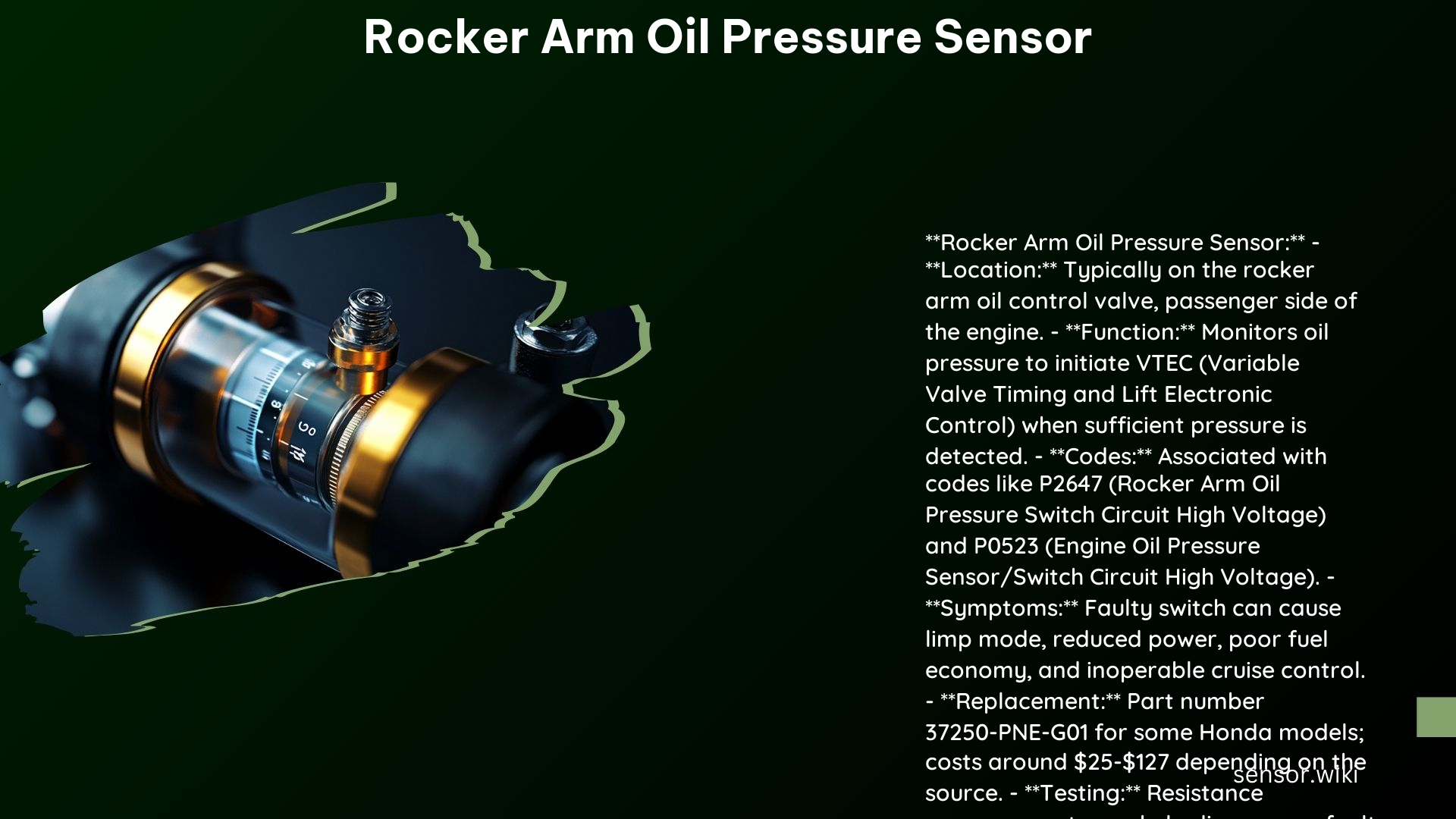Comprehensive Analysis of the Rocker Arm Oil Pressure Sensor
What are the Common Causes of a Faulty Rocker Arm Oil Pressure Sensor?
Mechanical Failures:
– Switch Failure: The rocker arm oil pressure switch can fail intermittently, leading to diagnostic trouble codes (DTCs) such as P3400 and P3497. This failure is often due to the switch itself rather than other mechanical components.
– Worn or Loose Components: While rocker arm issues (like loose rocker arms or a worn shaft) do not directly affect oil pressure, they can indicate broader engine problems that might indirectly impact the sensor’s performance.
– Clogged Oil Passages: Oil passages clogged with debris can prevent the sensor from receiving the correct oil pressure, leading to sensor malfunction.
Electrical Issues:
– Wiring and Connector Problems: Faulty wiring, damaged connectors, or corrosion in the connector areas can disrupt the signal from the sensor to the engine control module (ECM), causing the sensor to malfunction.
– PCM or Solenoid Failure: Failure of the Powertrain Control Module (PCM) or the rocker arm oil control solenoid can also affect the sensor’s operation.
Environmental Factors:
– Corrosion and Moisture: Moisture and corrosion in the connector areas can cause the sensor to fail. Using dielectric grease (electrode grease) on the connector areas after cleaning can help prevent this.
– Temperature Extremes: Some symptoms may be exacerbated by temperature changes, such as the Check Engine Light (CEL) staying on in hotter days and improving in colder days.
How to Clean the Rocker Arm Oil Pressure Sensor?
Tools and Materials Needed:
– Torx or hex keys (depending on the switch’s fastening method)
– Socket wrench or ratchet
– Dielectric grease (electrode grease)
– Cleaning agents (e.g., electrical contact cleaner)
– Soft-bristled brush or cloth
– Safety gloves and safety glasses
Step-by-Step Process:
- Disconnect the Battery: Ensure the vehicle’s battery is disconnected to prevent any accidental starts or electrical shocks.
- Locate the Sensor: Identify the rocker arm oil pressure switch, typically located on the rocker arm oil control valve.
- Remove the Switch: Use the appropriate tools to remove the switch. For example, on some Honda models, this involves removing the engine cover and disconnecting the switch connector.
- Clean the Connector: Use electrical contact cleaner and a soft-bristled brush or cloth to clean the connector areas. Ensure all debris and corrosion are removed.
- Apply Dielectric Grease: Apply a thin layer of dielectric grease to the cleaned connector areas to prevent future corrosion.
- Reinstall the Switch: Reinstall the switch, ensuring it is securely fastened. For Honda models, torque the switch to the specified value (e.g., 16 ft. lbs. or 22 Nm for the rocker arm oil pressure switch).
- Reconnect the Battery: Reconnect the battery and test the system to ensure the sensor is functioning correctly.
Safety Precautions:
– Wear protective gear: Use safety gloves and safety glasses to protect against electrical shock and chemical exposure.
– Ensure proper grounding: Make sure the vehicle is securely supported on a lift and grounded to prevent any electrical shocks.
What are the Symptoms Indicative of a Faulty Rocker Arm Oil Pressure Sensor?
Performance Metrics and Warning Lights:
– Check Engine Light (CEL): The CEL may illuminate with specific DTCs such as P3400, P3497, or P2647, indicating issues with the rocker arm oil pressure switch.
– Diagnostic Trouble Codes: Codes related to the rocker arm oil pressure switch will be stored in the ECM, such as P3400 (VPS Stuck Off Bank 1) and P3497 (VPS Stuck Off Bank 2).
– Oil Pressure Indicators: A “Low Oil Pressure” indicator on the instrument panel may be illuminated, or a “Check Engine Oil Level” message may appear on the MID or navigation screen.
Operational Anomalies:
– Intermittent Failures: The sensor may fail intermittently, making it difficult to duplicate symptoms after clearing the DTCs.
– Engine Performance Issues: Faulty sensor readings can affect engine performance, particularly in systems that rely on variable valve timing (VVT) or Variable Timing and Lift (VTEC).
Reference Links
- ALLDATA Community Automotive Diagnostic Team – [Switching It Up Honda Oil Pressure Switch Issues]
- MGB & GT Forum – [Low oil pressure because of rocker shaft]
- ClubRSX – [P2647: Rocker Arm Oil Pressure Switch – Diagnostic and Installation Help]
- Honda-Tech – [P2647]
- YouTube – [Causes and Fixes P2646 Code: “A” Rocker Arm Actuator]
The rocker arm oil pressure sensor is a critical component in modern engines, responsible for monitoring the oil pressure in the rocker arm assembly. A faulty sensor can lead to various performance issues and diagnostic trouble codes, making it essential to understand the common causes, cleaning procedures, and symptoms associated with this sensor.

